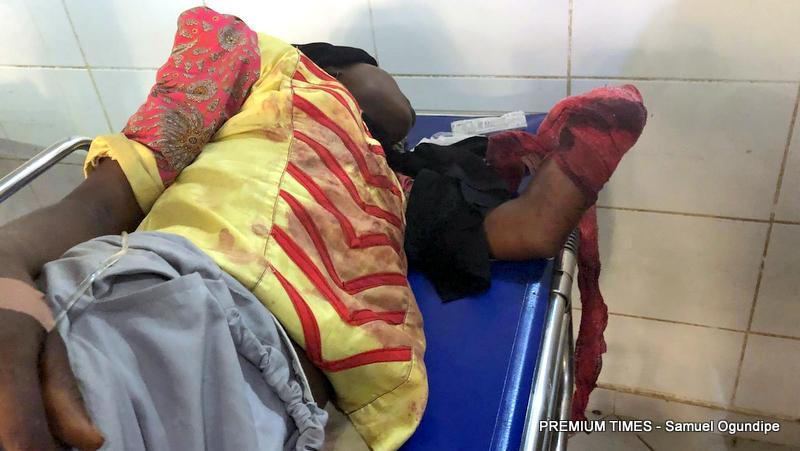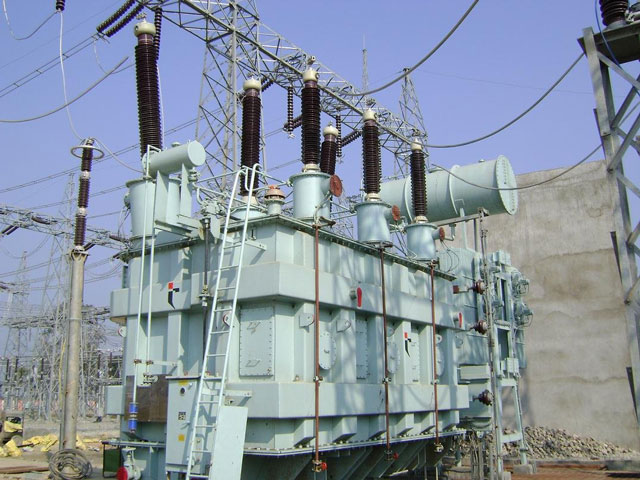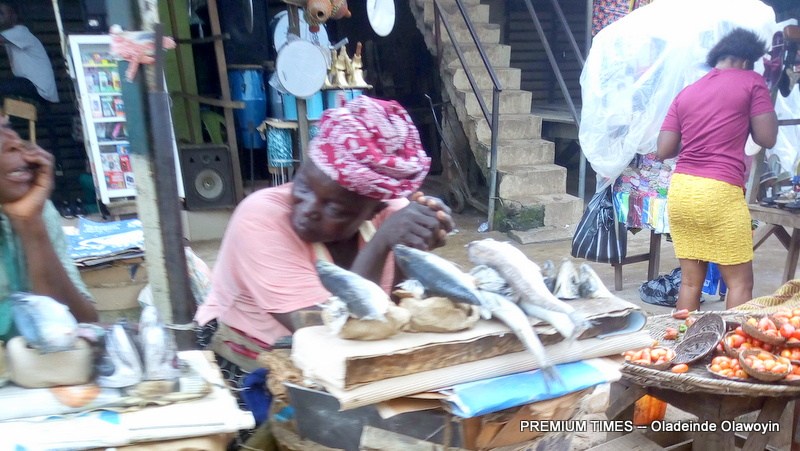The fresh evidence collected by this newspaper throughout Tuesday questions the official account by the Nigerian Army which said only three persons were killed. It perhaps also revealed the extent Nigerian authorities would go to downplay death toll of civilian victims of a tragedy, an age-long practice that has worsened in recent years despite the country being a member of various international convention on human rights.
The IMN members revealed to PREMIUM TIMES how they evacuated dozens of bodies of their loved fellow Shiites who were killed by a gun truck which the Nigerian Army deployed as part of its response to quell the protest.
The protest march was organised to commemorate the death of a grandson of Prophet Muhammad and further demand the release of the IMN leader who has been kept in custody for nearly three years despite repeated federal court orders for his release.
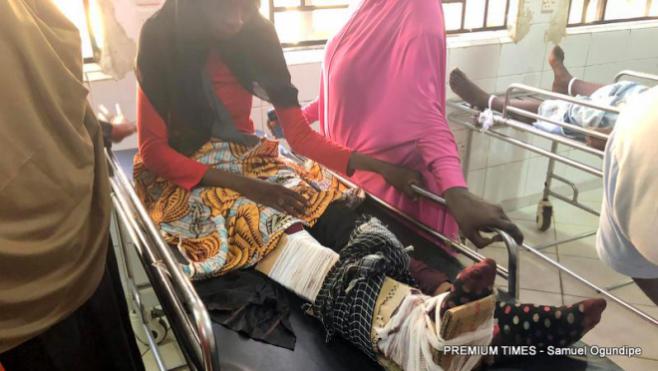
They Shiites evacuated the bodies of their members to the innermost corners of Mararaba-Old Karu, the neighbourhood where the violence broke out, preserving them in blocks of ice in defiance of grave health consequences that could arise from such unscientific and unhealthy practice.
The Morning After
Although there were no immediate signs revealing the level of mayhem unleashed around here as of Tuesday morning, residents of Mararaba and Old Karu who saw Nigerian soldiers open live rounds on Shiite protesters the afternoon before have said the horrific scenes of chaos would flash in their memories for an indefinite period of time.
A PREMIUM TIMES’ assessment of the scene on Tuesday morning showed the police have managed to secure a 800-metre stretch between Old Karu Bridge and Nyanya Bridge along Abuja-Keffi Highway, scene of the most deadly confrontation between the Nigerian military and members of the Islamic Movement of Nigeria since the December 2015 Zaria massacre.
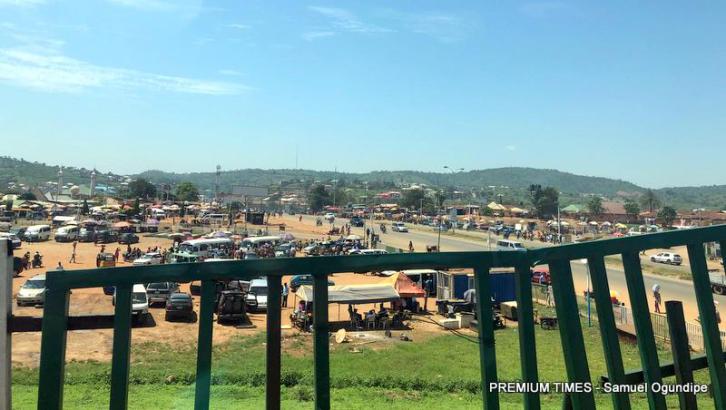
Both Karu and Nyanya lie just South-east of Abuja, with swathes of each interspersing between the Federal Capital Territory and Nasarawa State. As Abuja continues to expand, the communities have become some of the most robust satellite towns of the nation’s capital.
Many workers in Abuja call Mararaba or Karu home, their moderate economic status anchored largely on relatively cheaper access to accommodation and services.
The Nigerian Army admits responsibility for only three deaths from the incident, which it said came after four soldiers were injured with stones, sharp objects and Molotov cocktails allegedly thrown by protesters.
But members of the Shiite movement said at least 52 of their fellows were killed during the protest, which they said was planned to commemorate the death of Imam Hussein, a grandson of Prophet Muhammad, and also demand the release of Mr El-Zakzaky.
PREMIUM TIMES confirmed the death of 21 IMN members on Tuesday morning.
Mr El-Zakzaky, who was taken into custody shortly after his compound was raided by soldiers who massacred hundreds of his followers, has remained in the custody of the State Security Service more than two years later — in defiance of court orders that he should be released immediately in 2016.
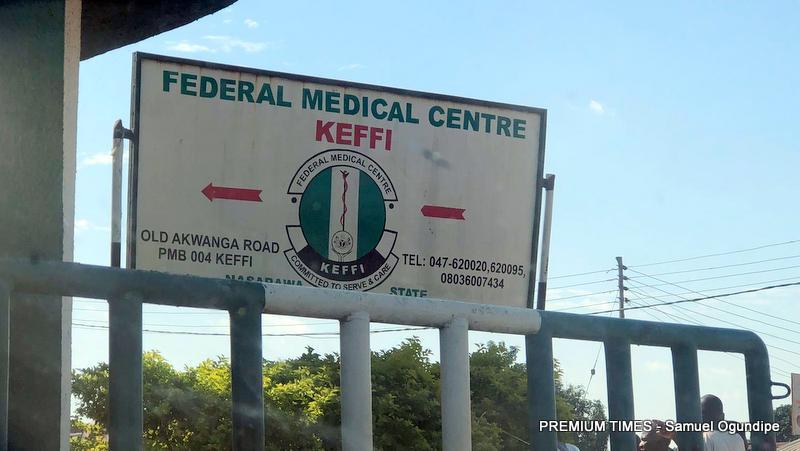
The IMN said it lost more than 1000 members in the attack that took place between December 12 and 14.
The Kaduna State Government admitted 347 bodies were handed over by the army for a secret mass burial. But despite the evidence, the army claimed it killed only seven Shiites who blocked a public road and attempted to assassinate its chief, Tukur Buratai, a lieutenant general. It said troops only used force after it became clear that Mr Buratai’s life was in danger.
A judicial panel later found the Nigerian Army officers culpable in the massacre of the 347 persons which state government admitted were killed; but none of them has been put on trial three years on.
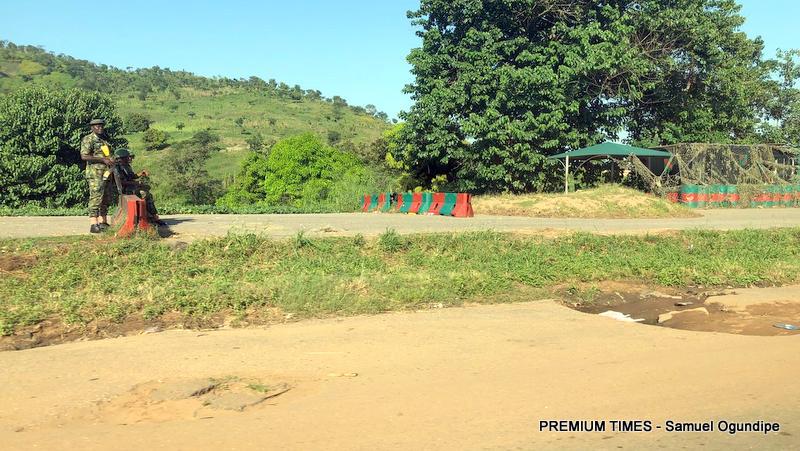
On Tuesday, a detachment of troops and riot police officers still stood guard under the overhead bridge that was marked as a buffer before the violence erupted on Monday afternoon, flanked by five police vans and a military gun truck which bore the inscriptions of Guard Brigade, an elite unit of the Nigerian Army.
Barely visible just adjacent them was a smoldering passenger vehicle which was tossed into the open drainage for Abuja outbound traffic. Witnesses said its passengers were caught in the fracas, with some of them jumping into a canal just 200 metres from the bridge in an attempt to escape ringing military gunshots.
Workers at Ikebest Nigeria Limited, facing a First Bank Branch in Mararaba, and Sani Brothers Filling Station, also in Mararaba, said they closed operation after the violence broke out and did not return on Tuesday morning.
On Monday evening, passersby, including people returning home from work, were stunned to discover the deadly mayhem on the streets. With no sign of the crisis immediately abating, many of them turned back into Abuja, and traffic was brought to a standstill.
A parking instructor at a motor park in Nyanya who witnessed the incident near the flyover bridge in Nyanya said the soldiers opened fire on the protesters after they rejected a plea by officers not to cross the military checkpoint by the Old Karu flyover.
“At first, the soldiers were shooting in the air. But when the protesters refused to go back and tried to force themselves through the barricade, then the soldiers started shooting them one by one,” the instructor said. He asked PREMIUM TIMES to withhold his identity for safety reasons, especially since he could be easily traced by security agencies.
He explained that the troops pursued fleeing protesters with live ammunition from Old Karu Bridge to Nyanya Bridge, leaving “more than 40” killed within the 800-metre stretch.
“The soldiers stopped shooting from the top of the van (the Guard Brigade gun truck) when they got here (Nyanya Bridge) because many people are here and they did not want people to see them killing people like that,” the instructor added.
The Old Karu Bridge where the military checkpoint was mounted following the April 2014 bombing in Nyanya is not surrounded by humans, unlike the Nyanya Bridge 800 metres away which is densely populated and busy with a major motor park and trading stores.
Another witness in the area said many of the fleeing protesters dived into a canal in-between the two bridges, and some never made it out alive.
Abdullahi Musa, one of the coordinators of the protest, told PREMIUM TIMES his junior sister was found in the canal on Tuesday morning, hours after the family had become worried she might have been killed.
“My sister sustained serious injuries and is now at the hospital, but many people did not make it out of the bridge alive,” the senior Shiite member said. “Many of them were not even Shiites.”
A Tuesday night statement by the sect said its Monday afternoon procession was peaceful. It accused the Nigerian military of premeditated murder and urged the foremost rights groups and international fora like the United Nations to hold Nigerian government accountable.
“There is no iota of truth in what they dished out to the public to justify their unjustifiable act of killing defenceless citizens who have trekked peacefully for over three hours without any incident from Maraba bus stop, only to find their path barricaded with armored vehicles and fully armed troops that resumed killing without any provocation,” Ibrahim Musa, a spokesperson for the sect, said.
“It was the troops who blocked the highway to prevent members of the Islamic Movement from entering Abuja for the Arba’een commemoration of the martyrdom of Imam Husain AS. This is an act of provocation to deny people their right to peaceful assembly; hence there is no way it can be justified,” he added.
No Resting Place?
A witness told PREMIUM TIMES shortly after the fracas broke out on Monday that some of those who were killed were denied burial at a nearby burial ground because they were Shiites. Mr Musa, however, said IMN members were not taken for burial on Monday.
“We did not take any member to the burial ground, those that they rejected were not Shiites, maybe they were Sunnis,” he said.
Mr Musa also took calls from female IMN members who said they were arrested by soldiers but had no idea where they were taken to, and expressed fears about their safety in military custody.
‘Preserving The Evidence’
As at Tuesday, the Shiites declined to bury the remains of those who were allegedly gunned down by soldiers. Instead those whose bodies they recovered were taken deep into the ghettos of Mararaba, where they tucked them in different houses.
PREMIUM TIMES confirmed 21 bodies, comprising 20 males and one female. They were preserved with blocks of ice in houses largely inaccessible by vehicle, stretching over three kilometres from Mararaba end of Abuja-Keffi Highway.
Three male bodies were covered in black sheets and laid on cardboard in an Islamic school which now serves as a refuge for many Shiite in the neighbourhood. A bucket filled with blocks of ice had just been brought in, but yet to be placed on the bodies to keep them from decomposing.
Eighteen bodies (looking mostly like 17 young adults and a female) were laid in three rows of five and seven in the inner room and five in the outer room, all swarmed by large flies.
The blocks of ice were placed on the neck, stomach and tucked in-between the legs of each body on the concrete. A strong, fetid odour buffeted from the outer room, uncurbed by the insufficient quantity of blocks of ice.
“We have to keep them here because the police and soldiers are going to seize them and lie that they did not collect the bodies from us,” one of the Shiites members preserving the bodies told PREMIUM TIMES. “We can keep them for at least two weeks as evidence against the Nigerian Army.”
They were indifferent towards the health hazards the obviously decomposing bodies pose.
“We have done this in Kano, Kaduna and other places where our members have been killed not too long ago,” a local Shiite leader said. “We know it cannot work like the freezer they use in hospital, but it can serve a temporary purpose.”
“That is why some the owners of the rooms moved out and volunteered them for us to use,” he added.
PREMIUM TIMES could not immediately obtain names of those killed because they had not been identified by their loved ones as of Tuesday evening.
In addition to the 21 bodies seen by PREMIUM TIMES, the Shiites also said nine bodies were seized by the officers at Asokoro Police Division. The three persons which the military admitted died during the mayhem were the bodies the soldiers took away from the scene.
Another three bodies were said to be in one of their hideouts in Keffi, Nasarawa State.
PREMIUM TIMES interviewed four wounded victims at the Federal Medical Centre in Keffi Tuesday afternoon, but could not locate the place where the three bodies were kept.
Abuja police commissioner, Bala Ciroma, said he could not immediately say whether or not nine Shiite bodies were in custody of the police Tuesday night.
Army Speaks
Spokesperson for the Nigerian Army, Texas Chukwu, declined to say whether or not the soldiers evacuated three bodies, or whether the death toll would be reviewed upward in the light of fresh evidence collected by PREMIUM TIMES.
John Agim, a chief military spokesperson, declined comments on the roles the military played in the havoc during a visit to the Defence Headquarters on Tuesday afternoon.
The killings come two days after a similar confrontation ensued in Zuba, another major suburb of Abuja, and a day before five persons were killed in fresh protest on Tuesday night in downtown Abuja.
At least six protesters were reportedly killed when soldiers opened fire on Shiite protesters Saturday afternoon near the main intersection in Zuba.
The Army said only three protesters were killed after they allegedly blocked a heavy duty vehicle conveying military equipment. Some soldiers were allegedly wounded during the incident.
The six deaths were identified as: Mikhail Shuaibu, from Dabai; Abdulaziz Maigana, Abu Dujana Ibrahim, from Suleja; Ukasha Isa, from Madalla; Sa’idu Khalil, from Mile 12 and Rabi’u Abdulwahab from Malumfashi.
The attack on Tuesday afternoon reportedly left five Shiite protesters killed. The police said some of their vehicles were set alight by the protesters, adding that at least 400 of them had been arrested as a result.
Gory Scene
At the Federal Medical Centre in Keffi, three female and one male IMN members were laying in critical condition.
Pius Ameh, the head of accident and emergency department, said the victims were driven about 35 kilometres to the hospital, arriving at about 10:00 a.m. Tuesday.
The left arm of one female had been crushed by bullets. The second female was totally unconscious of her environment because she had a bullet wound to the brain, and Mr Ameh said a neurologist had not examined her situation.
The male victim also had brain injuries and would require a surgery, the doctor said.
A 21-year-old woman, the youngest amongst the four, was brought to the hospital with a badly damaged right leg.
“We have been told since 7:00 a.m. that some victims of the Shiites and soldiers violence in Abuja on Monday would be brought to our hospital,” Mr Ameh said. “We are now assessing the level of injuries sustained by every one of them.”
At least 200 protesters were said to have been wounded, many of whom are said to be receiving treatment in undisclosed locations.
‘Disdain For Sanctity of Human Life’
The high casualty figure arising from the Nigerian soldiers handling of the latest Shiite protests has put the human rights record of the Nigerian government under renewed scrutiny amongst rights groups.
“What the military is doing is unacceptable,” Isa Sanusi, a spokesperson for Amnesty International Nigeria, told PREMIUM TIMES Tuesday night. “It is very horrific and it shows a clear disdain for the sanctity of life.”
“The soldiers have demonstrated excessive use of force and failed to conform with international standards for handling protests,” Mr Sanusi said. “We call on the government to investigate this and bring perpetrators to justice.”
“This reckless disregard for the sanctity of human life should not be sanctioned by any government, and this government should not be seen as condoning it.
“It was in 2015 December that over 350 were killed, but up till today, no one has been brought to book. The courts have also ruled that the Shiite leader and his wife should be released, which would have prevented the frequent protests by his followers.
“People have a right to peaceful protest and assembly and the government must do everything possible to protect their rights. This must not go on,” Mr Sanusi added.
The Human Rights Watch also condemned the tactics the military deployed in suppressing the protests, declaring the action as a breach of fundamental rights of citizens.
“The use of such deadly force to quell protests accused of throwing stones and pellets at soldiers is disproportionate and unjustifiable,” Aniete Ewang, Nigeria country researcher for the Human Rights Watch, told PREMIUM TIMES in a statement Tuesday night. “The actions of the soldiers are unlawful and a violation of the fundamental human rights of the protesters.”

